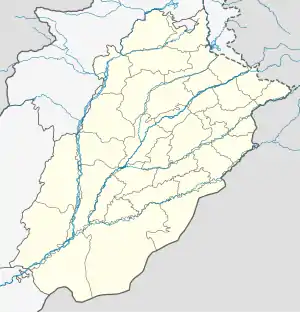قلعہ بجنوٹ | |
 Shown within Punjab, Pakistan  Bijnot Fort (Pakistan) | |
| Alternative name | Winjhrot[1] |
|---|---|
| Location | Bahawalpur District, Punjab, Pakistan |
| Region | Cholistan Desert |
| Coordinates | 28°5′22″N 71°40′55″E / 28.08944°N 71.68194°E |
| Type | Fortification |
| History | |
| Founded | 8th century AD[2] |
Bijnot Fort (Urdu: قلعہ بجنوٹ), is a ruined fortress located in Bahawalpur District of Punjab, Pakistan, 23 kilometres (14 miles) west of Indo-Pakistani border in Cholistan Desert.[3][4]
History
Constructed in the 8th century, Bijnot Fort now stands in ruins, primarily due to targeted artillery shelling during the Indo-Pakistani War of 1971, rather than natural deterioration.[2]
It was under the occupation of Rajputs until 18th century.[5]
Outlaws connection
The fort's narrative isn't its historical significance, but the infamous outlaws who frequented it.[2] Madho Singh, a Rathore clansman from Bikaner, became a fugitive after retaliating violently against a neighbor's insult towards his father.[2] Escaping to Jaisalmer, he joined a gang of minor criminals, swiftly rising to leadership due to his imposing stature and Rajput dignity.[2] The gang's criminal activities escalated, leading to a significant heist and subsequent relocation to Pakistan in 1948, near Fort Abbas.[2]
The gang's cross-border criminal activities led to a confrontation with Rajasthan Police, resulting in the death of Madho's deputy, Krishen Singh.[2] His ashes, according to local lore, were sent to the Ganga River.[2]
After the incident, Madho Singh secured an audience with the Nawab of Bahawalpur, gifting him a richly decorated camel.[2] Consequently, Madho Singh and his remaining gang were permitted to settle in Dera Nawab, the Nawab's seat of power.[2]
Traditionally, Poorbia Rajputs served as the Nawab's harem guards.[2] After Bahawalpur's incorporation into Pakistan, these guards returned to India, leading to Madho Singh and his gang assuming this duty.[2] However, they soon relocated to the desert, resuming cross-border operations and escalating their criminal activities.[2]
By 1963, Madho Singh was allegedly involved in 135 cases in India.[2] In an act of revenge for a fallen comrade, Madho kidnapped Bhoor Singh.[2] Despite pursuit, they avoided capture.[2] Eventually, Madho executed Bhoor Singh, leading to his own capture and subsequent 14-year custody without trial or conviction.[2]
In 1978, Madho and his gang were released, thanks to human rights lawyer Abid Minto, and granted Pakistani citizenship.[2] Seeking peace, Madho rejected offers of protection tied to criminality, opting for lawful living under the shelter of Lal Mian Abbasi.[2] He died in 1983, ensuring his remaining gang pledged law-abiding loyalty to the Abbasi family.[2] This pledge was upheld until the last accomplice, Moolji, died in 1999.[2]
See also
References
- ↑ Imperial Gazetteer2 of India, Imperial Gazetteer of India -- Digital South Asia Library (Volume 8 ed.). p. 202. Retrieved 22 May 2017.
- 1 2 3 4 5 6 7 8 9 10 11 12 13 14 15 16 17 18 19 20 21 Salman Rashid (20 June 2014). "Bijnot Fort". Retrieved 22 May 2017.
- ↑ "قلعہ بجنوٹ جسے شہاب الدّین غوری نے مسمار کروا دیا تھا". ARYNews.tv. December 8, 2022.
- ↑ "چولستان میں صدیوں پرانے تاریخی قلعے". jang.com.pk.
- ↑ "Of Tunno and his Bijnot".
